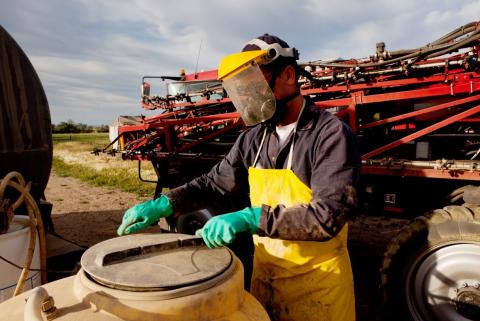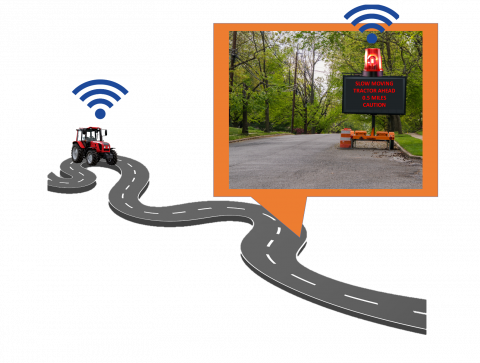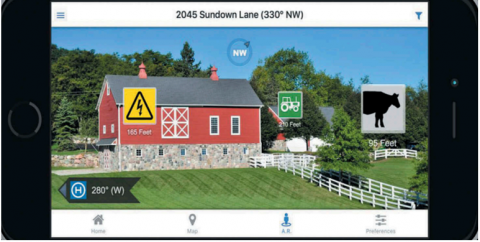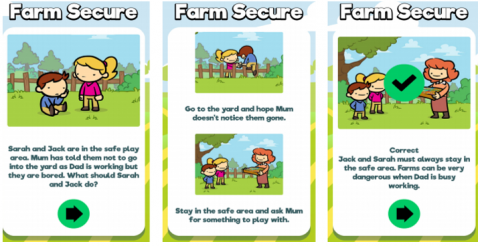25 January 2021
Dr David Cutress: IBERS, Aberystwyth University.
- The agricultural sector is statistically one of the most dangerous industries globally but there are several possible tools, guides and schemes which could help farmers
- Farmers mindsets surrounding farm safety need to be changed – danger doesn’t need to be the norm
- Technological developments could help farms move towards a safer future farm environment if implemented correctly
Safety on farms
The agricultural sector (often combined in its statistics with the fishing, forestry and horticulture sectors based on HSE data) is known as one of the most dangerous industries in which an individual can work in the UK. This is not a trend limited to the UK either, as figures for the United States, Canada, Finland, Norway, Sweden, Greece, Switzerland, Ireland, Gambia, Ethiopia, Australia, New Zealand, Korea, Bangladesh and India show a reported fatality rate within agriculture of between 10.9 and 30.6 per 100,000 persons per year making farming in many countries the highest risk sector. The total annual cost of injuries (in farming, forestry and horticulture) to UK society is estimated at £190 million. Despite the agricultural work force only accounting for 1% of the UK total it represents 20% of the total reported worker related deaths. This has consistently been an area of concern for both local and global health and safety and policymaker consideration. The EU Directive 89/39/EEC ensures minimum levels of health and safety requirements are present in workplaces and alongside this the UK’s Health and Safety Executive (HSE) performs inspection activities enforcing the ‘Management of Health and Safety at Work Regulations 1999’ on farms. The HSE also set out a specific strategic plan for the agriculture sector in 2017. As well as the evidence of high risk it is also commonly discussed that reporting on agriculture specific injuries lags behind other industries, despite it being one of the highest risk sectors. This has led to certain bodies creating their own agricultural injury databases such as AgInjuryNews. As well as being sites which can collate data these can also provide information and advice and help shape policy based on the patterns of occurrences uncovered. Furthermore agricultural work is linked with twice the national average occurrence of asthma (due to high allergen or other sensitizer exposures, agricultural dust exposures and aerosolised chemical exposures such as with pesticides) and due to the close interaction with animals it acts as an area of high risk for the transfer of zoonoses (diseases passed from animals to humans), with an estimated 20,000 people being affected each year in the UK.
Injuries and fatalities can occur in a variety of ways with figures present at GOV.UK on fatal injuries in agriculture. An area which has seen static levels of change are deaths due to contact with machinery, suggesting this may be an area where safety measures could have an impact. Due to the risks involved GOV.UK and other Government linked bodies supply comprehensive guides surrounding health and safety in this sector highlighting key risks such as fall prevention, vehicle safety and the high risk of machinery elements such as PTO shafts. Similarly farmer focused bodies such as the NFU provide extensive farm safety guides which should be carefully considered and reviewed to reduce risks on farms. Furthermore a major cause of farm injuries may be associated with the disconnect between farmers perceptions of highest risk and the statistical objective data of where most fatal accidents occur, suggesting that farmers need to be communicated with and educated more effectively to improve their hazard understandings.
Mitigations
Providing significant mitigations for high risk hazards on farms is vital to reducing the numbers of injuries and fatalities each year. But these are not the only benefits that such strategies can have. The HSE lists the benefits including financial gains, output gains and reduced insurances, as such it is clear that mitigation management changes should be of high concern to farmers. A key improvement could be to implement strict training with the advice of designated physicians or farm consultants who can help highlight hazards. Training strategies are often most well received in peer-to-peer farmer-to-farmer communications an area where schemes such as ‘The Wales Farm Safety Partnership’ can help through providing events to highlight farm safety. Equally Farming Connect provides support which facilitates peer-to-peer mentoring as well as training and e-learning courses.
General farm machinery and engineering developments and innovation appear to reduce the severity of fatal injuries, a multi-year US study predicted that engineering advances accounted for 63% of the total reductions seen between 1992 – 2015. However, it is known that aged machinery is common among family run small farms, where updating these to newer safer models can be unaffordable, therefore maintaining older machinery often increases the risks present.
Power take off (PTO) shaft injuries are high risk in agriculture with several cases occurring every year, some of which are fatal. A key aspect to minimising such risk is in the use of correct PTO guards and regular maintenance and assessment of condition. The NFU have specific guidelines surrounding safe PTO usage with initiatives such as the ‘Growing Safer Farmers’ launched in 2017 aiming to help train and inform farmers to improve safety. Data also suggests PTO shields being damaged or missing in 57% of cases assessed in a New York study suggesting this is still an area of concern. Another well studied aspect of tractor safety is foldable roll-over protective structures (FROPs) which are present in many tractors. These can act to reduce the severity of injury or prevent fatality in roll-over incidents but can be difficult to fold-up and down in many instances often contributing to farmers leaving these down and lacking protection. Other more practical engineering considerations which should be common across all agricultural vehicles include wrap around seats, cabin audio alarms, internal cushioning systems (particularly focused on the head and chest) and sensors such as inclinometers linked to automated braking and engine shutdown controls during perceived accidents.
Technological/Precision solutions
Many technological and precision solutions are being developed and already exist which can assist in improving farm safety. One common mitigation strategy not touched upon above is the use of personal protective equipment (PPE). Whilst these are vital in improving farm safety they are also an area where improved technologies and precision integrated technologies could offer enhanced benefits. Smart PPE is an area which has mostly been researched due to older and lone working farmers being subject to higher risk. Areas of potential smart PPE are listed below, whilst many are not optimised for agriculture they could be transferable. A key consideration in smart wearables is providing something a farmer can’t “forget to pick up or put on”.
|
PPE |
Adaptations |
Measurements and systems |
Links |
|||
|
Headwear |
Smart hard hats |
Body temp, heart rate, external temp, alarms, radar to warn of obstacles |
||||
|
Smart helmets |
Regulate air flow, control noise levels |
|||||
|
Smart flat caps |
Fatigue sensing, electroencephalography (EEG) |
|||||
|
Hand protection |
Smart gloves |
Scan barcodes (adapt to scan RFID tags), obstacle alerts, GPS, temp and heating |
||||
|
Feet protection |
Smart shoes |
Steps, calories, fall detection |
||||
|
Smart socks |
Gait analysis, health status, activity |
|||||
|
Clothes |
Smart vests |
GPS monitoring, alerts |
||||
|
Smart firefighter wear |
GPS and physiological changes such as temperature |
|||||
|
Astroskin - vest |
Blood pressure, activity, skin temp, blood O2, breath rate |
|||||
|
General |
PPE task matching |
Detects if correct PPE is worn for the task |
||||
Adapting medical alarm pendants, which are often used for at risk or elderly individuals, to alert when falls and accidents occur is a possibility. This can be seen in the smart stick as a concept for farmers and senior citizens, a mobile network coverage-based device. This involves users setting up a profile including health information that can be transmitted in the event of an accident. This walking stick incorporates a lightning detector/alarm, GPS, SOS button, fall detection, torch light, phone charger, speaker (to play alarms or AM or FM radio) and Bluetooth connectivity. Similarly, smartwatch/fitness watch technologies could be adapted for farmers in order to monitor vitals and provide a route for signalling an alarm. Difficulties with rural systems can include providing a description of the location to ensure assistance arrives in the right place. GPS can provide accuracy up to 3 - 5 metres in most systems (such as mobile phones), but apps such as what3words can add to the locational description as this provides each 3m x 3m square with a unique identifier.
In addition to these single devices, total precision safety systems, including accelerometers and pressure sensors linked to GPS on devices worn by farmers can monitor ‘bio-signs’ and provide alerts if these fall outside normal ranges (either to a central monitoring system or direct to emergency services). Such systems could alert emergency services and include any health information (blood type, age, medical history) which could assist in treatment. Video based farm safety monitoring has also been proposed to monitor incidents which occur and can be combined to assist in security and in reducing the need for farm-wide inspections which may expose farm staff to hazards when performed in person.
As noted above a core facet of injuries in agriculture are physical injuries, systems which can help prevent such injuries and continued damage include the increased use of automation over physical labour and innovations in areas such as exoskeleton technologies. Exoskeletons involve a ridged external frame to support parts of the body. Adoption of exoskeletons in agriculture have been noted to have potential in reducing health and safety risks with up to 65% reductions seen in back muscular load when performing farm activities. Experts currently suggest back and knee supports being of highest interest for agricultural workers. However, adoption barriers highlighted include exoskeletons getting caught on equipment, comfort, unexpected failure issues and increased fall risks. Where automations is concerned this can range from automated or assisted tractor controls to robotics, which offer a route to replace human labour in some “dirty and dangerous” jobs. This can ethically be seen as beneficial as it could minimise human health risks. Robotics and greenhouse spraying can minimize risks of farmer inhalation and health issues of pesticides or chemicals. Adaptations as simple as standardising automated doors on heavy machinery storage could help save farm time and minimise risks via sensors to prevent closing if there are obstructions from staff or vehicles. Automated milking is an area where animal handling is reduced so farmer safety may be improved. However, research in Norway suggests whilst physical risks are reduced there is increased demand on farmers to act as comprehensive health and safety managers to any employed staff due to increased cognitive demands and understanding which comes with these systems and training staff in their safe use.
Another area of noted high risk is asphyxiation, this is an area where precision gas monitoring can help to alleviate the issues for slurry tanks or even risks of indoor livestock environments. Monitors allow warnings about excess/dangerous levels of gas building up and in integrated facilities can be linked with automated ventilation systems to alleviate this gas build up without human intervention. Air quality for dust as a risk factor for agricultural workers is currently being highlighted by the World Health Organisation (WHO) as a growing concern for human, animal and plant health globally. Precision sensors integrated into indoor environments linked to ventilation systems can activate these as and when required.
An interesting consideration for agricultural traffic related accidents was proposed whereby digital signs/warning lights could be placed near key farm areas that can communicate with terminals on the machinery, informing incoming traffic that a slow moving tractor is on the road ahead. Other consideration for safety could include driverless car based sensors to avoid collisions, automatic braking and internal sensors to assess driver conditions and drowsiness. One example warns against potential mistakes occurring using ear canal temperature changes and blinking eye and heart rate patterns. Papers also suggest one of the biggest factors on increased risks of falls from agricultural vehicles may be tiredness linked to hours worked causing increased unsafe behaviours.
Whilst technology use and distraction has been readily focused on in roadway vehicles with many campaigns (such as ‘no text is worth dying for’) present within our media, little focus has been placed on technology use on farm vehicles. In an analysis of farm-worker youths (ranging from 14-18 years old) it was found that up to 47% of respondents sometimes or often answer a phone or read a text whilst operating farm equipment (inclusive of tractors, ATVs, skid steer and trucks/car), with on average 5.75% (standard deviation 3.87%) of youths sometimes or often using other phone based apps.
Safety based apps have been suggested which link to emergency services needing to know the hazards and risks present on farm, as a lack of knowledge can put the services themselves at increased risk. American apps such as FARM-HAT and MAPPER use augmented reality (AR) like ’Pokémon Go’ where farmers can view hazards around them on farm and highlight these for other workers or emergency services.
Similarly, as many farms are also homesteads and involve families, child and youth farm safety can be a significant concern with statistics of farm accidents in children being higher than desired. One group of researchers are trying to address this by developing a specific farm safety and awareness app that appeals to children between the age of 5-11 years old.
3 Mock-up of children farm safety app taken from Reid et al., (2018)
Other systems have been designed which look to track farm workers through a day to assess farm working times to improve government data collection. Whilst there could be potentially negative implications regarding trust and data freedom, there could be positive beneficial gains to prevent managers exploiting and dangerously over-working farm staff which is noted to be linked with increased injury rates.
Such consideration of technologies within the agricultural sector have a significant level of potential. However, many of these are reliant on local communications or mobile internet based communications, which are not equally available in many rural farming regions globally and in the UK. One route to prevent the restriction of such technologies to certain rural farmers is the incorporation of models which utilise wide area networks (WANs) such as devices being trialled and refined by the Farming Connect European Innovation Partnership (EIP) funded project aimed at farm safety and security. Security and health particularly become an increased issue in lower income areas/countries where agricultural crime and attempting to prevent it can lead to injuries and death. This project will utilise long range wide area network (LoRaWAN) technologies to help largely combat thievery but may also integrate SOS style alert systems for lone working as the project develops.
Summary
As one of the highest risk areas both in the UK and globally health and safety in the agricultural sector are of major concern. Whilst levels of injuries and fatalities have generally declined over the years there are still improvements to be made. It is clear based on multiple research findings that increased effectivity in informing farmers of safety concerns (through new media such as social media) and engaging farmers in safety training should be a focus of future reductions of farm-based accidents. However, any such programmes may need to address the underlying issues that farm worker behaviour and attitude often inherently underplay danger or actively encourages hazardous practices and that despite it being a requirement, many farm business’ lack fully comprehensive risk assessments. As engineering and technologies have developed, machinery (or more particularly tractor) based accidents have been reduced, however, many such technologies with improved safety considerations can be expensive, limiting and endangering smaller less lucrative farming businesses. As the sector increasingly moves towards an automation assisted agriculture 4.0 future, precision technologies are and could also be developed to assist with several aspects of farming safety. Where these are considered however, it is important they integrate well with farmer practices so as not to add unnecessary barriers to their use.




